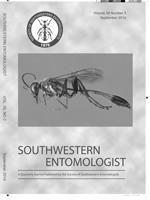The blackberry, Rubus sp., crop in the state of Michoacán, Mexico is the second-most important crop after avocado, Persea americana Mill., in relation to value of production and employment. In this study was identified a blackberry leafroller, its parasitoids, and population dynamics in two commercial orchards at Michoacán, Mexico, during the growing seasons of 2007 and 2008. Collected rolled leaves containing larvae and pupae where maintained in a laboratory until leafroller adults and their parasitoids emerged. Population dynamics of moths were determined using wing traps containing the sex pheromone of Argyrotaenia citrana (Fernald) (Lepidoptera: Tortricidae). Numbers of males caught peaked in September and November 2007 at the two locations. After these months, numbers gradually decreased to almost zero during the dry season in 2008. Moths that emerged were identified as Argyrotaenia montezumae (Walsingham) (Lepidoptera: Tortricidae). Of the A. montezumae larvae collected in the field, 38% were parasitized by Apanteles near aristoteliea Viereck (Hymenoptera: Braconidae), 9% by Colpoclypeus michoacanensis Sánchez and Figueroa (Hymenoptera: Eulophidae), and 3% by unidentified specimens of the family Ichneumonidae. Males of A. montezumae were attracted to the sex pheromone of A. citrana. The greatest number of moths trapped during the growing season coincided with the periods of intense vegetative growth and harvest.
How to translate text using browser tools
1 September 2014
Identification, Parasitoids, and Population Dynamics of a Blackberry Leafroller (Lepidoptera: Tortricidae) from Michoacán, Mexico
Ignacio López,
Samuel Pineda,
José Isaac Figueroa,
José Antonio Sánchez,
Ana Mabel Martínez,
Roger N. Williams,
Ángel Rebollar-Alviter
ACCESS THE FULL ARTICLE

Southwestern Entomologist
Vol. 39 • No. 3
September 2014
Vol. 39 • No. 3
September 2014




